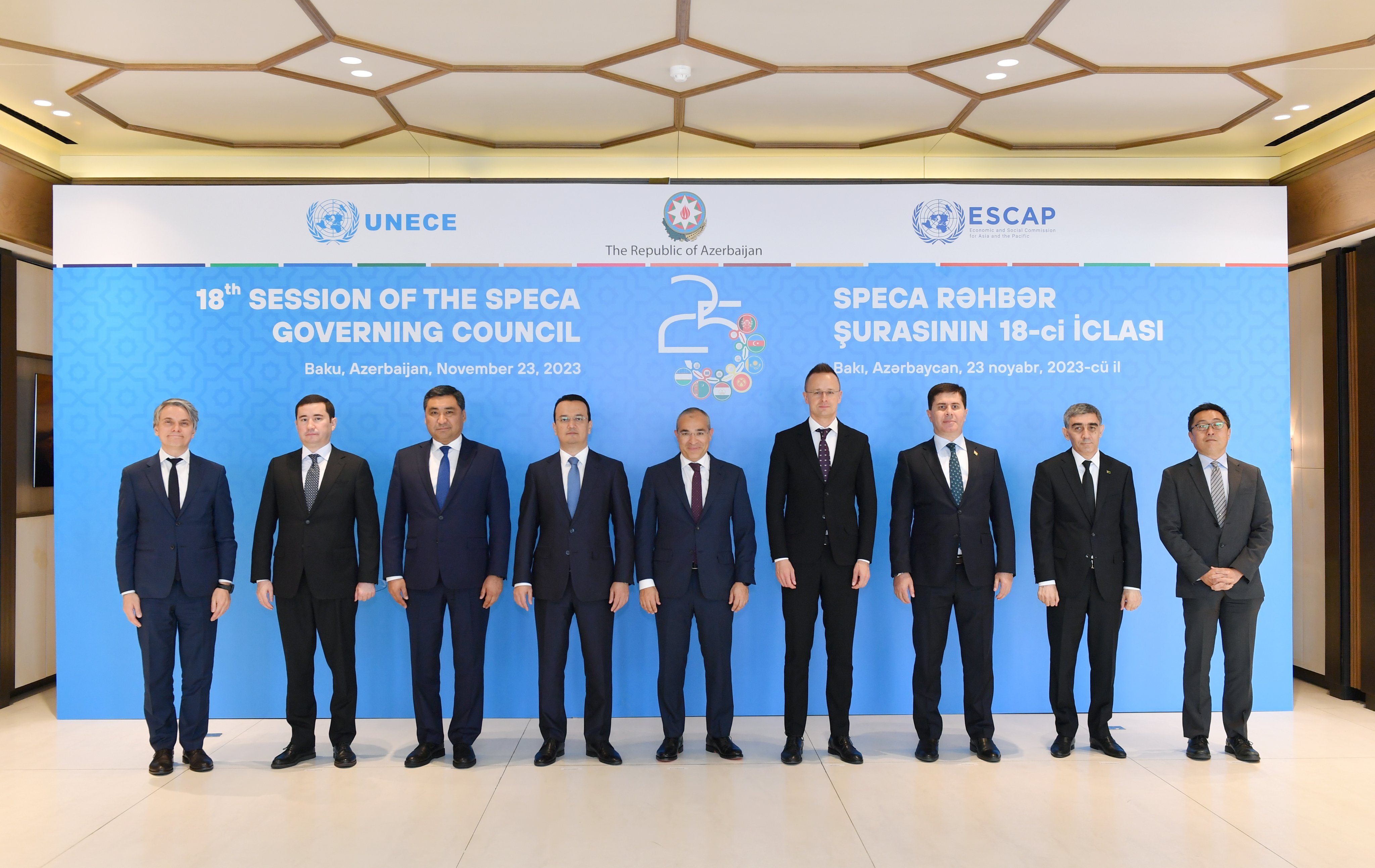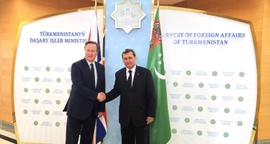SPECA countries discussed multiple issues of mutual interest, including Azerbaijan’s initiatives as a central transport and logistics hub, during the 18th meeting of the SPECA Governing Council in Baku on Thursday.
Representatives from Azerbaijan, Kazakhstan, Uzbekistan, Turkmenistan, Kyrgyzstan, Tajikistan, and Afghanistan exchanged ideas on fostering partnerships in traditional and renewable energy sectors, as well as transport, communications, and other sectors.
Azerbaijani delegation presented the country’s initiatives as a central transport and logistics hub for contributing to regional integration and connectivity, with the key focus on the East-West Middle Corridor projects supported by SPECA countries.
The United Nations Special Programme for the Economies of Central Asia (SPECA) launched in 1998 to strengthen the sub-regional cooperation in Central Asia and its integration into the world economy through collaborations among member states.
On Tuesday, at "Transforming the SPECA Region into a Connectivity Hub with Global Outreach" economic forum, Azerbaijan’s Economy Minister Mikayil Jabbarov said Baku increased the volume of trade turnover with SPECA countries by 3.6 times from 2021 to $1.3 billion in 2022. January-October this year, the trade volume hit $1.2 billion, which is 16% more than in the same period of 2022, Jabbarov noted.
“Azerbaijan serves as a trade hub between East and West for other SPECA countries. We focus on cross-border cooperation,” Jabbarov stated per the local media.
The transport sector is of greater interest to the SPECA member states in light of the geographical implications of connectivity routes running through their territories. In addition, landlocked countries of the region seek to harness collective efforts to ensure new arteries for their economies to sail into global markets.
The Central Asian region, with its limited reach to Western markets due to its geography, has been seeking economic diversification by throwing weight behind various ambitious projects such as China’s Belt and Road Initiative (BRI) and the Trans-Caspian International Transport Route (TITR), also known as the Middle Corridor.
SPECA and the Middle Corridor
The Middle Corridor is economical and faster compared to the Northern Corridor as a trade route between Europe and Asia and shrinks the travel distance by 2,000 kilometers. The multimodal land and sea transport route stretches from China through Kazakhstan, Uzbekistan and Turkmenistan, and, across the Caspian Sea through Azerbaijan and Georgia to the Black Sea.
The route consists of about 4,250 km of rail lines and about 500 km of seaway. The ultimate destination of the corridor is the European marketplace via Türkiye and the Black Sea.
The Middle Corridor also runs through more favorable climate conditions and shortens the travel time by 15 days compared to the sea route. Furthermore, the Middle Corridor offers great opportunities for cargo traffic in Asia so that the loads can reach the Middle East, North Africa and the Mediterranean region by integrating the port connections in Türkiye.
If used effectively, the Middle Corridor is expected to create important economic opportunities, enabling South Caucasian and Central Asian countries to benefit from China-Europe trade, which is valued at $600 billion annually. In particular, the establishment of logistical centers and free trade zones at the ports of Azerbaijan, Kazakhstan and Turkmenistan will facilitate the development and deepening of Trans-Caspian cooperation.
Kazakhstan is a vital link in the East-West connectivity between China and Europe. The country’s strategic location and access to the Caspian Sea offer a second-to-none transit capacity in fostering the realization of East-West transport projects.
On November 5, 2017, the first cargo train carrying 600 tons of wheat left Kazakhstan toward the Turkish port of Mersin via the Baku-Tbilisi-Kars (BTK) railway on the Middle Corridor route. The train completed the 1,258-km journey between the two destinations in about 30 hours.
The first successful transit of goods encouraged the Kazakh authorities to expand their plans for the BTK railway and the Middle Corridor as a whole to plug the Central Asian region into the Caspian basin, further paving the way to European markets. In June, Kazakh authorities teamed up with colleagues from Azerbaijan and Georgia to unify rail tariffs and set up a joint logistics company.
Landlocked Uzbekistan is also keen on integrating its domestic transportation grids into the Middle Corridor. The country’s trade is suffering from the disruption of transport chains and rising transport costs as it has no access to the sea and is thus dependent on free transport routes. In addition, growing East-West connectivity redesigns Europe as an increasingly important market for diversifying Uzbekistan’s exports.
The Middle Corridor can also bring the mass flow of goods closer to the country with Tashkent providing transit for some of them for positioning itself as a regional hub and facilitating its integration into international value chains. Uzbekistan has already started to export more through the port in Turkmenbashy, Turkmenistan.
For Afghanistan, integration into the global economy is possible through the Lapis Lazuli trade corridor running to the seaports of Turkmenbashy and Baku, as well as the Georgian maritime ports of Poti and Batumi. The route further cuts into the cities of Kars and Istanbul in Türkiye with further access to the transport grid of Europe.
In July, Kyrgyz authorities agreed with the government of Azerbaijan to attract additional loads to the Middle Corridor with Bishkek offering its transport and transit capacities. In June, Turkmenistan and Tajikistan teamed up to develop an action plan on creating a new transport corridor as part of the Middle Corridor route that will allow both countries to access Europe via the Caspian Sea.







 U.S. Secretary of State Antony Blinken reiterated Washington’s unwavering support for the ongoing peace process between Azerbaijan and Armenia in a...
U.S. Secretary of State Antony Blinken reiterated Washington’s unwavering support for the ongoing peace process between Azerbaijan and Armenia in a...
 Iran is moving to fortify its eastern border with Afghanistan in a bid to fight illegal migration and drug trafficking, along with enhancing security.
Iran is moving to fortify its eastern border with Afghanistan in a bid to fight illegal migration and drug trafficking, along with enhancing security.
 The Iranian and Cuban transport ministers have discussed expanding maritime and air transportation cooperation.
The Iranian and Cuban transport ministers have discussed expanding maritime and air transportation cooperation.
 Kyrgyzstan has joined the extensive reconstruction efforts in the Karabakh region of Azerbaijan, after a series of mega initiatives were launched b...
Kyrgyzstan has joined the extensive reconstruction efforts in the Karabakh region of Azerbaijan, after a series of mega initiatives were launched b...



